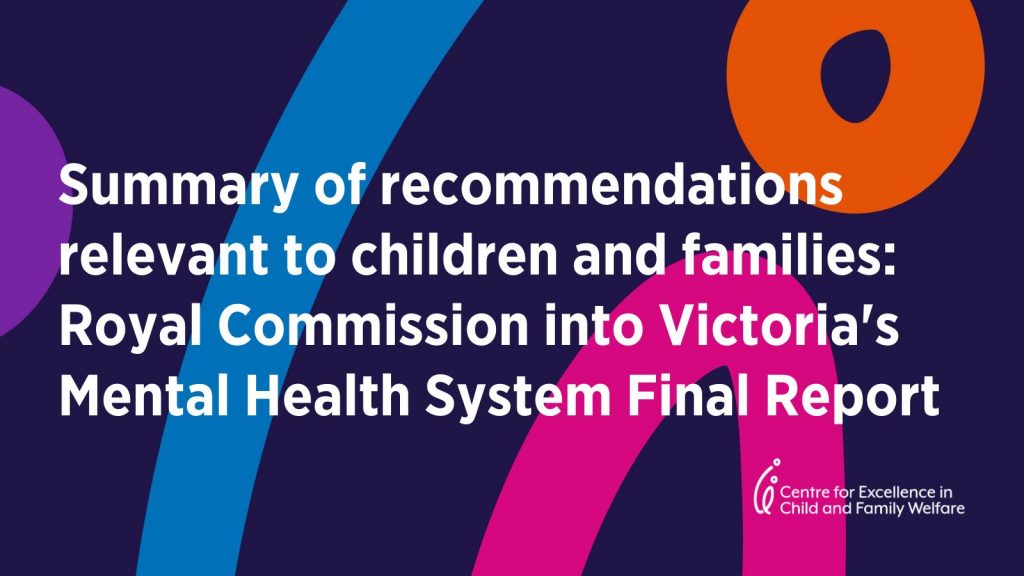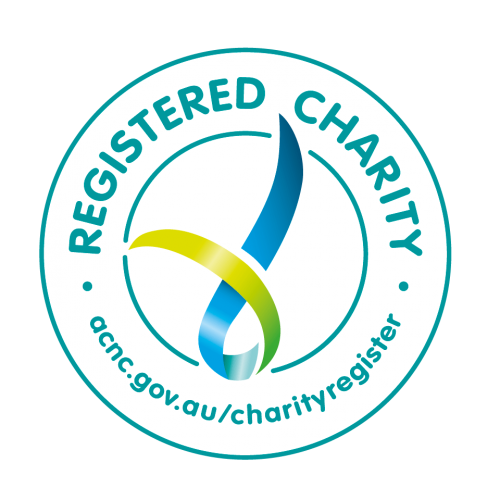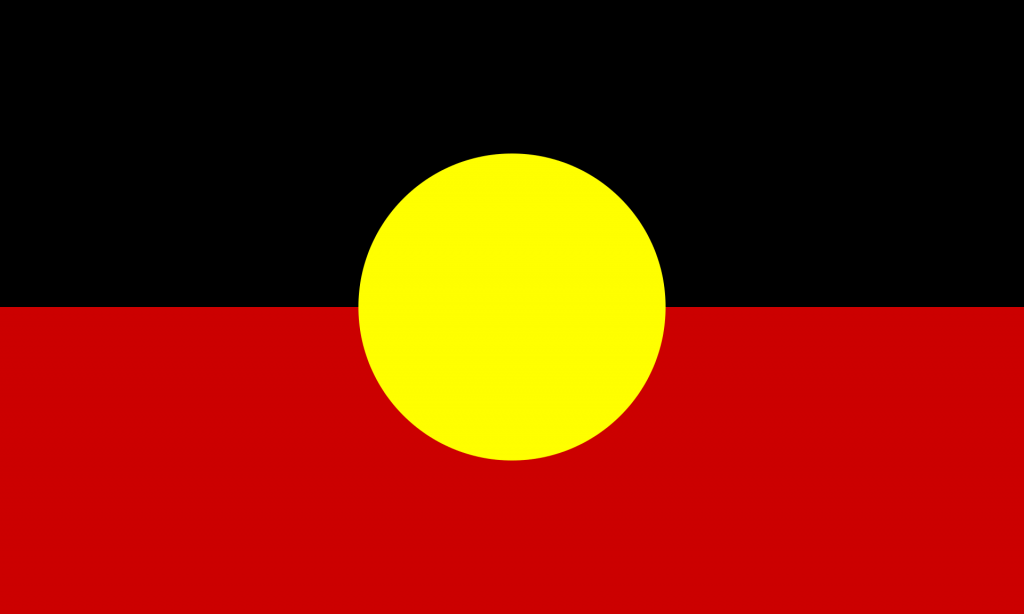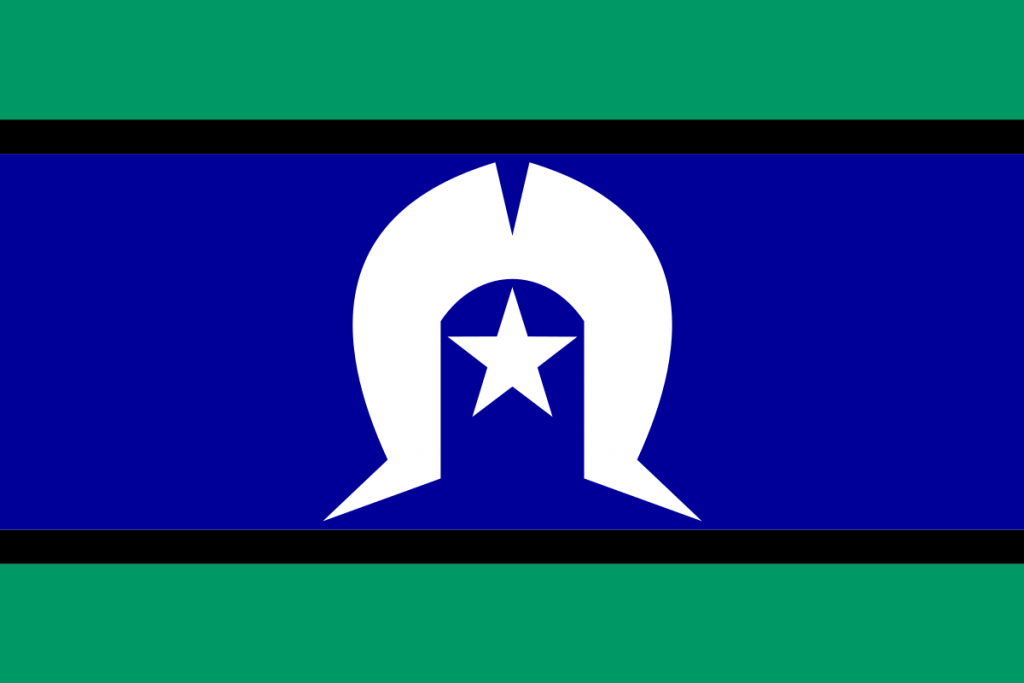The final report of the Royal Commission into Victoria’s Mental Health System contains 65 recommendations, and the Victorian Government has committed to implement each and every one.
This below summarises the recommendations most relevant to the child and family services sector and the infants, children, young people and families we support.
Download the Centre’s summary.
Recommendation 1 – Supporting good mental health and wellbeing (p. 37)
- build on the interim report’s nine recommendations and develop a Mental Health and Wellbeing Outcomes Framework to drive collective responsibility and accountability for mental health and wellbeing outcomes across government portfolios.
- through a newly established Mental Health and Wellbeing Cabinet Subcommittee, chaired by the Premier, use the Mental Health and Wellbeing Outcomes Framework to monitor outcomes to inform planning and policy decisions.
- use the Mental Health and Wellbeing Outcomes Framework as a mechanism to inform government investment processes and assess the benefits, including the economic benefits, of early intervention.
- update the Mental Health and Wellbeing Outcomes Framework and publicly report on progress against outcomes at a service, system and population level, every year.
Recommendation 2 – Governance arrangements for promoting good mental health and preventing mental illness (p. 38)
- establish a Mental Health and Wellbeing Promotion Office and enable it to develop and coordinate a statewide approach to the promotion of good mental health and wellbeing and the prevention of mental illness.
Recommendation 3 – Establishing a responsive and integrated mental health and wellbeing system (p. 39)
- establish a responsive and integrated mental health and wellbeing system, in which people receive most services locally and in the community throughout Victoria, close to their families, carers, supporters and networks.
- establish service delivery across Victoria at local, area-based and statewide levels comprising:
a. between 50 to 60 new Adult and Older Adult Local Mental Health and Wellbeing Services that operate with extended hours and are delivered in a variety of settings;
b. 22 Adult and Older Adult Area Mental Health and Wellbeing Services delivered through partnerships between public health services or public hospitals and nongovernment organisations that deliver wellbeing supports;
c. 13 Infant, Child and Youth Area Mental Health and Wellbeing Services delivered
through partnerships between public health services or public hospitals and nongovernment
organisations that deliver wellbeing supports; and
d. statewide services that are delivered in a way that minimises the need for people to
travel far to access services.
- remove rigid boundaries (or catchments) for service delivery based on where people live.
Recommendation 4 – Towards integrated regional governance (p. 40)
- by mid 2021, establish eight interim regional bodies to provide advice to the Mental Health and Wellbeing Division in the Department of Health as it plans, develops, coordinates, funds and monitors a range of mental health and wellbeing services in each region.
- establish a multiagency panel in each region to coordinate as required the delivery of multiple mental health and wellbeing services for people living with mental illness or psychological distress, including children and young people, who may require ongoing intensive treatment, care and support.
Recommendation 7 – Identifying needs and providing initial support in mental health and wellbeing services (p. 43)
- ensure mental health and wellbeing services provide three ‘needs identification and initial support’ functions:
a. access and navigation support;
b. initial support discussions; and
c. comprehensive needs assessment and planning discussions.
- ensure these functions are delivered based on a philosophy of ‘how can we help?’ to enable people to be supported from their first to their last contact with mental health and wellbeing services.
Recommendation 8 – Responding to mental health crises (p. 44)
- ensure each Adult and Older Adult Area Mental Health and Wellbeing Service delivers a centrally coordinated 24-hours-a-day telephone/telehealth crisis response service accessible to both service providers and to members of the community of all ages.
Recommendation 9 – Developing ‘safe spaces’ and crisis respite facilities (p. 45)
- in collaboration with the new agency led by people with lived experience of mental illness or psychological distress and non-government organisations that deliver wellbeing supports, establish four safe space facilities across the state, comprising a mix of drop-in spaces and crisis response services, co-designed with and for young people.
Recommendation 15 – Supporting good mental health and wellbeing in local communities (p. 51)
- establish and recurrently resource ‘community collectives’ for mental health and wellbeing in each local government area.
- support each community collective to bring together a diversity of local leaders and community members to guide and lead efforts to promote social connection and inclusion in Victorian communities.
Recommendation 17 – Supporting social and emotional wellbeing in schools (p. 53)
- fund evidence-informed initiatives, including anti-stigma and anti-bullying programs, to assist schools in supporting students’ mental health and wellbeing.
Recommendation 18 – Supporting the mental health and wellbeing of prospective and new parents (p. 54)
- expand and reform the community perinatal mental health teams in each Adult and Older Adult Area Mental Health and Wellbeing Service across Victoria.
- review approaches to perinatal mental health screening.
Recommendation 19 – Supporting infant, child and family mental health and wellbeing (p. 55)
- establish one responsive and integrated infant, child and youth mental health and wellbeing system to provide developmentally appropriate mental health and wellbeing treatment, care and support for newborns to 25-year-olds.
- by the end of 2022, establish a dedicated service stream for infants, children and their families, consisting of Infant, Child and Family Area Mental Health and Wellbeing Services, within the 13 Infant, Child and Youth Area Mental Health and Wellbeing Services to:
a. provide developmentally appropriate mental health and wellbeing treatment, care and support services for newborns to 11-year-olds and their families; and
b. adapt and deliver the core functions of community mental health and wellbeing services, including through a range of delivery modes, ensuring services are accessible and responsive to the diversity of local communities.
- by the end of 2022, and in partnership with the Commonwealth, establish three infant, child and family health and wellbeing multidisciplinary community-based hubs.
- deliver evidence-informed online parenting programs and group-based parenting sessions.
- establish two statewide subacute residential family admission centres located in the community.
Recommendation 20 – Supporting the mental health and wellbeing of young people (p. 56)
- by the end of 2022, establish a dedicated service stream for young people, consisting of Youth Area Mental Health and Wellbeing Services, within the 13 Infant, Child and Youth Area Mental Health and Wellbeing Services to:
a. appropriately adapt and deliver the core functions of community mental health and wellbeing services set out in recommendation 5, including through a range of delivery modes and ensuring services are accessible and responsive to the diversity of local communities; and
b. provide both short-term and ongoing treatment, care and support to young people, including those who require ongoing intensive treatment, care and support.
- ensure Youth Area Mental Health and Wellbeing Services are available for young people aged 12 to 25 (until a person’s 26th birthday), with age boundaries and transitions to be applied flexibly by services in partnership with young people and their families, carers and supporters.
- support the development of formal partnerships, step-up and step-down referral pathways, shared staff and infrastructure and co-location between headspace centres and Infant, Child and Youth Area Mental Health and Wellbeing Services.
- work with the Commonwealth Government, headspace National and Primary Health Networks to ensure that Infant, Child and Youth Area Mental Health and Wellbeing Services become the preferred providers of headspace centres where they exist or are established in Victoria.
Recommendation 21 – Redesigning bed-based services for young people (p. 57)
- review, reform and implement new models of multidisciplinary care for bed-based services for young people that are delivered in a range of settings, including in young people’s homes and in fit-for-purpose community and hospital environments.
Recommendation 23 – Establishing a new Statewide Trauma Service (p. 59)
- by the end of 2022, establish a Statewide Trauma Service hosted within the Collaborative Centre for Mental Health and Wellbeing, to deliver the best possible mental health and wellbeing outcomes for people of all ages with lived experience of trauma.
Recommendation 24 – A new approach to addressing trauma (p. 60)
- in collaboration with the Statewide Trauma Service, enable each of the 22 Adult and Older Adult Area Mental Health and Wellbeing Services and each of the 13 Infant, Child and Youth Area Mental Health and Wellbeing Services to employ up to three specialist trauma practitioners.
Recommendation 25 – Supported housing for adults and young people living with mental illness (p. 61)
- invest in a further 500 new medium-term (up to two years) supported housing places for young people aged between 18 to 25 who are living with mental illness and experiencing unstable housing or homelessness.
Recommendation 31 – Supporting families, carers and supporters (p. 67)
- by the end of 2022, commission non-government organisations to use consistent branding and deliver one family and carer-led centre in each of the eight regions.
- establish a statewide peer call-back service for families, carers and supporters caring for people experiencing suicidal behaviour.
Recommendation 32 – Supporting young carers (p. 68)
- by the end of 2022, fund a non-government organisation such as the Satellite Foundation to co-design and expand the range of supports across Victoria for young carers and children and young people who have a family member living with mental illness or psychological distress.
- by the end of 2022, broaden the scope and reach of the Families where a Parent has a Mental Illness program.
Recommendation 33 – Supporting Aboriginal social and emotional wellbeing (p. 69)
- resource Infant, Child and Youth Area Mental Health and Wellbeing Services to support Aboriginal community-controlled health organisations by providing primary consultation, secondary consultation and shared care.
- resource Aboriginal community-controlled health organisations to commission the delivery of culturally appropriate, family-oriented, social and emotional wellbeing services for children and young people.
- resource the Victorian Aboriginal Community Controlled Health Organisation, in partnership with an Infant, Child and Youth Area Mental Health and Wellbeing Service, to design and establish a culturally appropriate, family-oriented service for infants and children who require intensive social and emotional wellbeing supports.
Recommendation 34 – Working in partnership with and improving accessibility for diverse communities (p. 70)
- ensure the active engagement of Victoria’s diverse communities throughout the process of planning, implementing and managing the reformed mental health and wellbeing system.
- by the end of 2021, provide recurrent funding to Switchboard Victoria to deliver its Rainbow Door program, at scale, to support people who identify as lesbian, gay, bisexual, trans and gender diverse, intersex, queer and questioning to navigate and access the mental health and wellbeing system.
Recommendation 37 – Supporting the mental health and wellbeing of people in contact with, or at risk of coming into contact with, the criminal and youth justice systems (p. 73)
- expand specialist youth forensic mental health programs to a statewide model, including across the 13 Infant, Child and Youth Area Mental Health and Wellbeing Services, to provide consistent and appropriately specialised treatment, care and support to children and young people in contact with, or at risk of coming into contact with, the youth justice system.
Recommendation 39 – Supporting the mental health and wellbeing of people in rural and regional Victoria (p. 75)
- in addition to ensuring rural and regional communities receive the benefits of the Royal Commission’s recommended responsive and integrated mental health and wellbeing system:
a. provide additional resources to enable mental health and wellbeing services operating in regional Victoria to deliver services to small or geographically isolated rural communities; and
b. by the end of 2022, trial two new digital service delivery initiatives in rural and regional areas that meet the needs of local communities.
Recommendation 40 – Providing incentives for the mental health and wellbeing workforce in rural and regional areas (p. 76)
- address mental health and wellbeing workforce supply needs in rural and regional areas and establish an incentive scheme with a focus on attraction and retention.
Recommendation 63 – Facilitating translational research and its dissemination (p. 99)
- identify and promote opportunities to increase collaboration in translational research on the mental health and wellbeing of infants, children and young people.
Download the Centre’s summary.
Read more about the recommendations in the final report.
Content in this summary is largely included verbatim from the report. Some recommendations are only partially included or have been summarised. Please refer to the report for full details.






